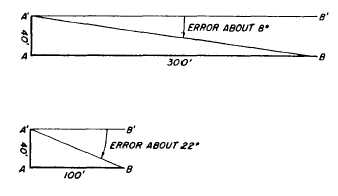If the instrument is not level, the measurement
of both horizontal and vertical angles will be
inaccurate.
3. The line of sight through the telescope must
be perpendicular to the horizontal axis. If it is not,
the line of sight through the telescope inverted will
not be 1800 opposite the line of sight through the
telescope erect.
4. The horizontal axis of the telescope must
be perpendicular to the vertical axis. If it is not,
the measurement of both horizontal and vertical
angles will be inaccurate.
5. The axis of the telescope level must be
parallel to the line of sight through the telescope.
If it is not, the telescope cannot be accurately
leveled. If the telescope cannot be accurately
leveled, vertical angles cannot be accurately
measured.
6. The point of intersection of the vertical and
horizontal cross hairs must coincide with the true
optical axis of the telescope. If it doesn’t,
measurement of both horizontal and vertical
angles will be inaccurate.
NOTE: Any or all of the above conditions
may be absent in an instrument that is defective
or damaged, or one that needs adjustment or
calibration.
Identifying Natural Errors
Common causes of natural errors in transit
work are as follows:
1. Settlement of the tripod in yielding soil. If
the tripod settled evenly—that is, if the tip of each
leg settled precisely the same amount—there
would be little error in the results of measuring
horizontal angles. Settlement is usually uneven,
however, which results in the instrument not
being level.
2. Refraction—but the effect of this is usually
negligible in ordinary precision surveying.
3. Unequal expansion or contraction of
instrument parts caused by excessively high or low
temperature. For ordinary precision surveying, the
effect of this is also usually negligible.
4. High wind may cause plumbing errors
when you are plumbing with a plumb bob and
cord and may also cause reading errors because
of vibration of the instrument.
Identifying Personal Errors
Personal errors are the combined results of
carelessness and of the limitations of the human
Figure 13-28.-Exaggerated illustration of error caused when
the transit is not centered exactly over the occupied
station.
eye in setting up and leveling the instrument and
in making observations.
Common causes of personal errors in transit
work are as follows:
1. Failure to plumb the vertical axis exactly
over the station. Figure 13-28 shows how the result
of inaccuracy increases drastically as the sight
distance decreases. In that figure, an instrument
supposed to be set up at A was actually set up
at A´, 40 ft away from A. (For demonstration
purposes the figure was exaggerated to magnify
the error; in actual practice the eccentricity
amounts only to a fraction of an inch. Remember
that mathematically, 1 in. is the arc of 1 min when
the radius is 300 ft.)
In the upper view, you can see that with B
located 300 ft from A, the angular error caused
by the displacement is about 8°. In the lower view,
however, with B located only 100 ft from A, the
angular error caused by the displacement is about
22°.
The practical lesson to be learned from this
is that you must plumb the instrument much more
carefully for a short sight than for a long one.
2. Failure to center plate level bubbles exactly.
The result of this is that the instrument is not
leveled exactly. The consequent error is at a
minimum for a horizontal sight and increases as
a sight becomes inclined.
The practical lesson is that you should level
the instrument much more carefully for an incline
sight than for a horizontal one.
13-25


